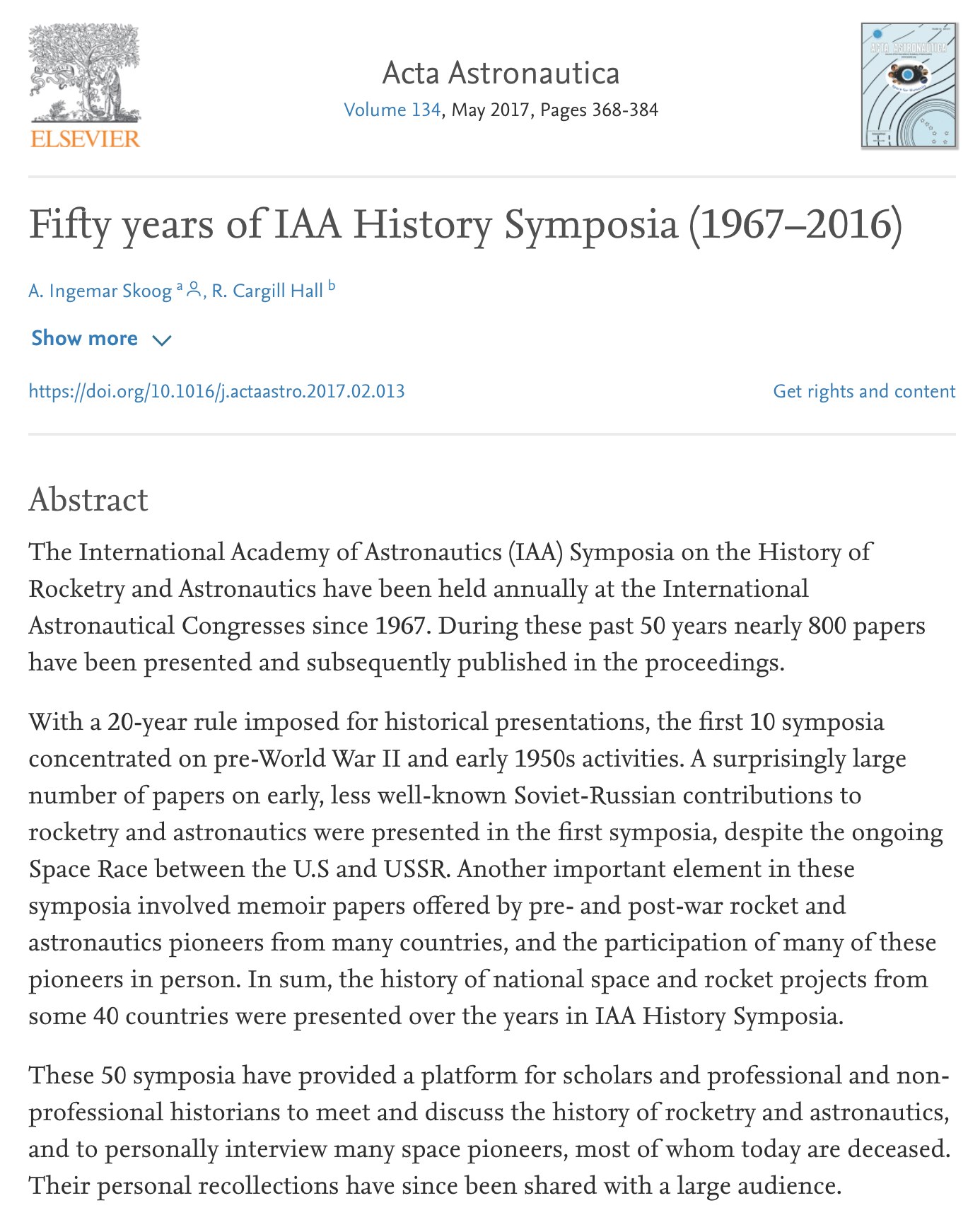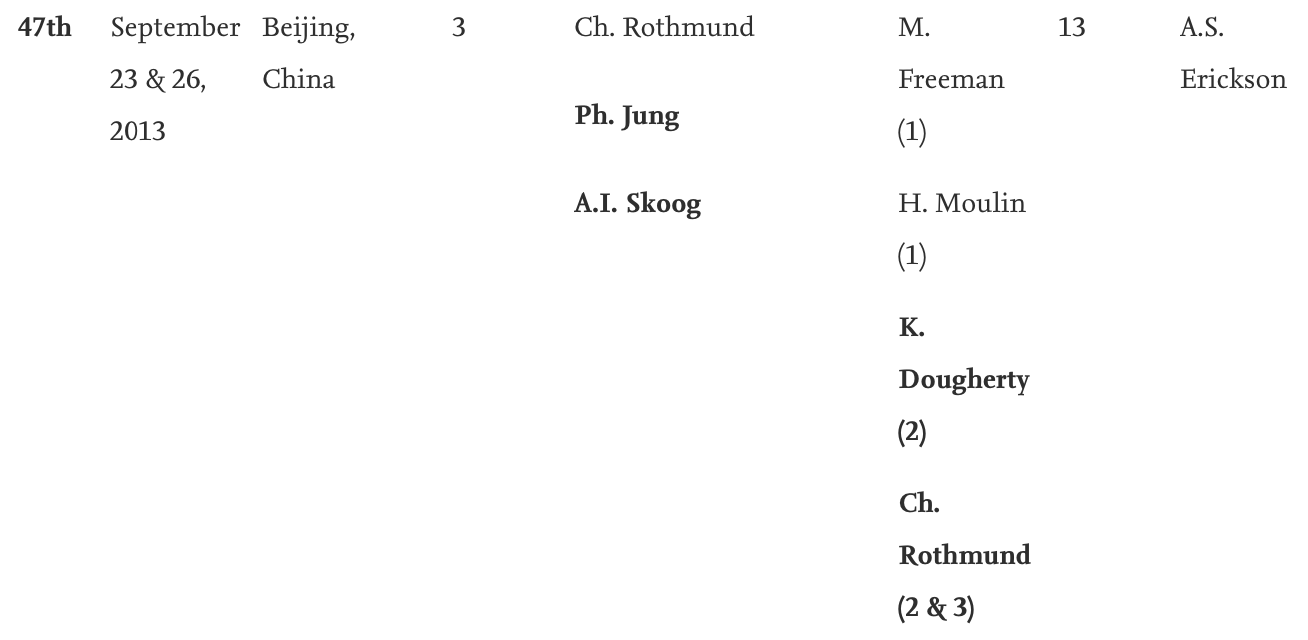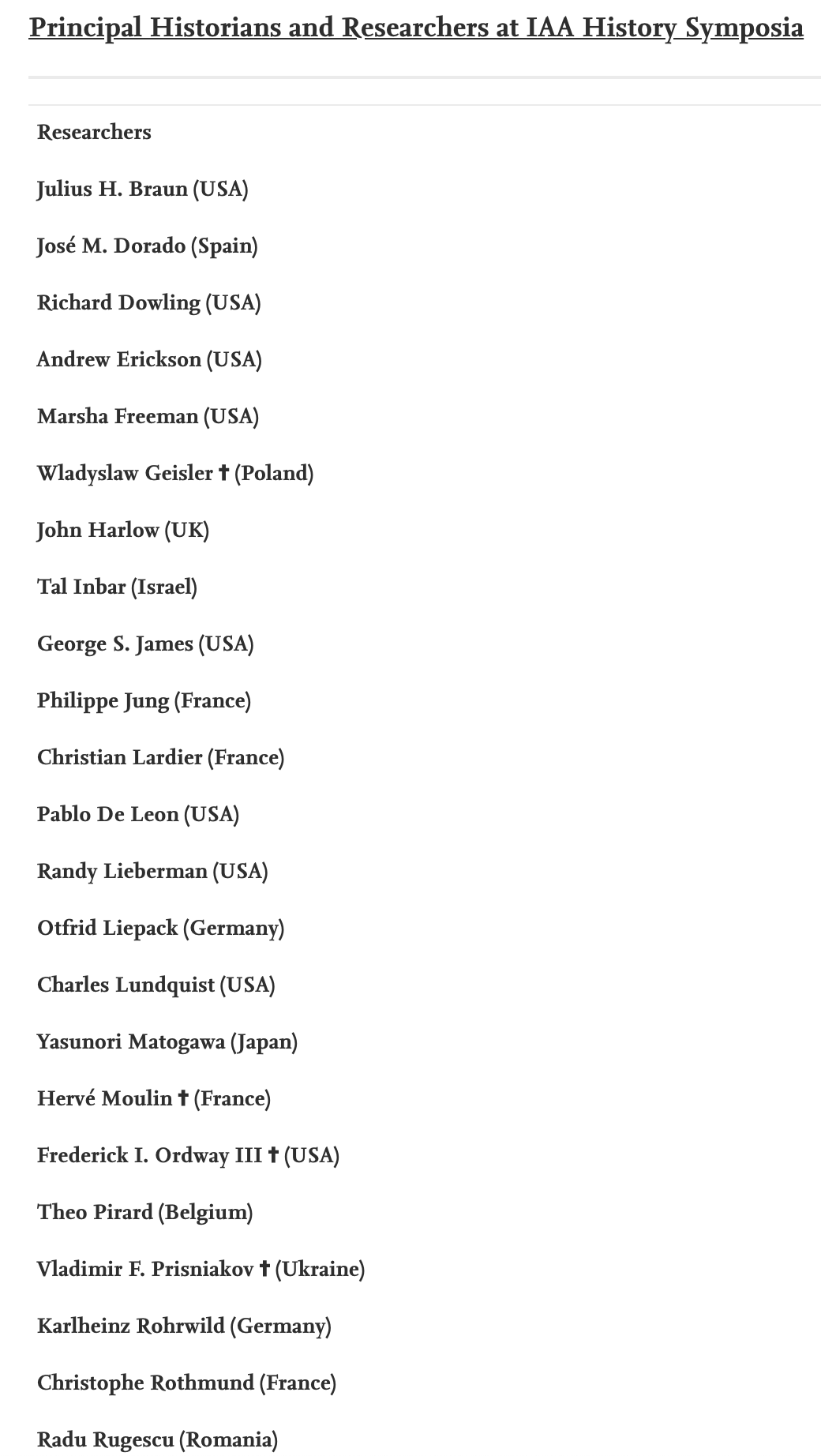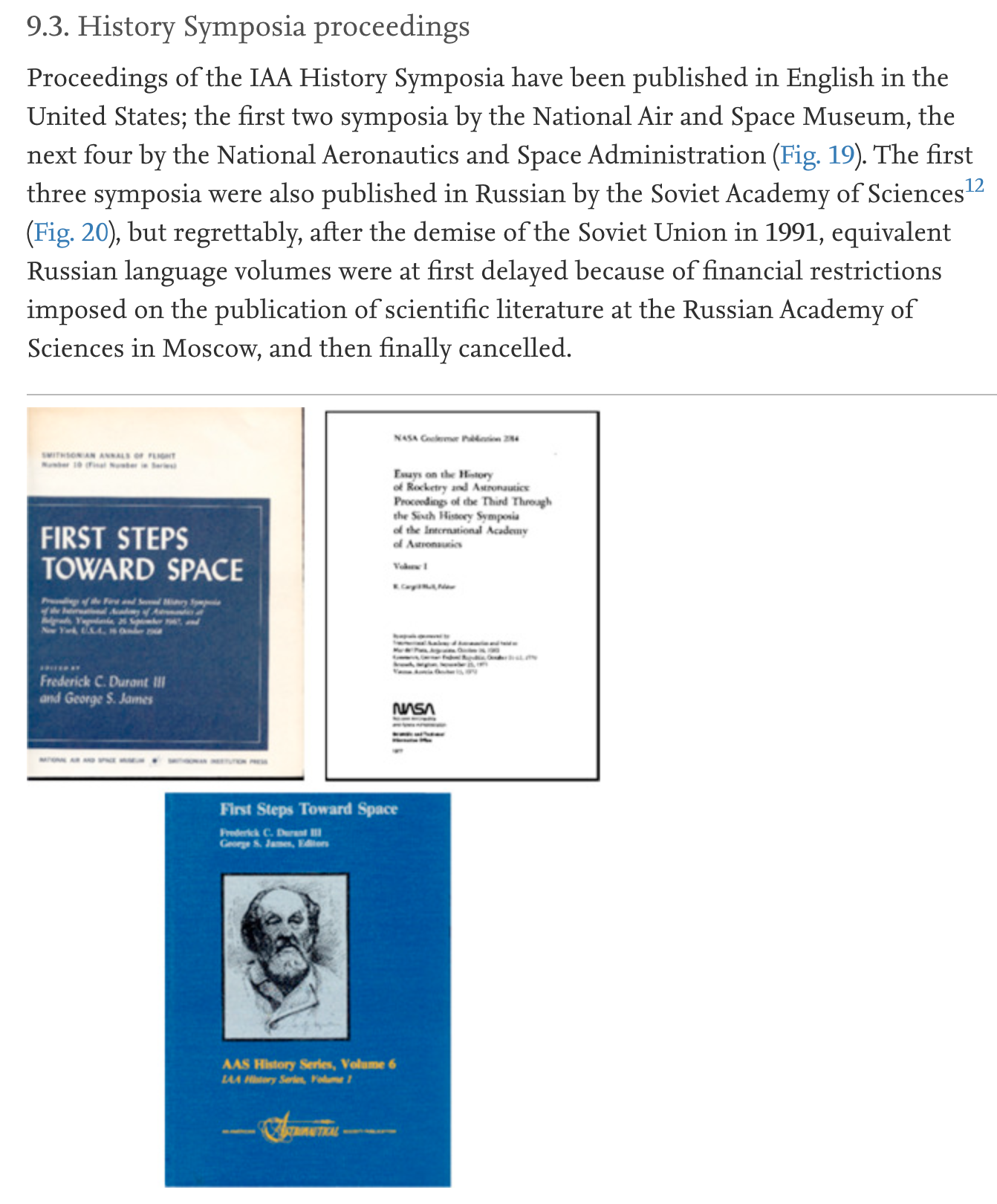The Definitive History: International Academy of Astronautics (IAA) Symposia on the History of Rocketry & Astronautics
Ingemar Skoog and R. Cargill Hall, “Fifty Years of IAA History Symposia (1967–2016),” Acta Astronautica, Volume 134, (May 2017): 368-84.
a International Academy of Astronautics, Immenstaad, FRG
b International Academy of Astronautics, Arlington, TX, USA
The International Academy of Astronautics (IAA) Symposia on the History of Rocketry and Astronautics have been held annually at the International Astronautical Congresses since 1967. During these past 50 years nearly 800 papers have been presented and subsequently published in the proceedings.
With a 20-year rule imposed for historical presentations, the first 10 symposia concentrated on pre-World War II and early 1950s activities. A surprisingly large number of papers on early, less well-known Soviet-Russian contributions to rocketry and astronautics were presented in the first symposia, despite the ongoing Space Race between the U.S. and USSR. Another important element in these symposia involved memoir papers offered by pre- and post-war rocket and astronautics pioneers from many countries, and the participation of many of these pioneers in person. In sum, the history of national space and rocket projects from some 40 countries were presented over the years in IAA History Symposia.
These 50 symposia have provided a platform for scholars and professional and non-professional historians to meet and discuss the history of rocketry and astronautics, and to personally interview many space pioneers, most of whom today are deceased. Their personal recollections have since been shared with a large audience.
Over time, IAA history papers divided into recognizable periods: ancient times through the 19th century, and the 20th and 21st centuries, which separate among actions and events that took place before 1945, in 1945 to 1957, and after 1957 (which marked the beginning of the space age). Proceedings of the IAA History Symposia have been published in English, ultimately in the History Series of the American Astronautical Society (AAS) and its publishing arm, Univelt Inc., under an agreement secured with the IAA.
This paper presents an overview of the IAA History Symposia. It examines the early years of the history committee and its first symposium, the evolution of subsequent symposia, and it recognizes those individuals who shaped these symposia and the publication of its proceedings. …
Attendees and presenters have included scholars, pioneers of rocketry and astronautics, and specialists in science and engineering associated with rocketry and space flight. Over the years, the history of astronautics in some 37 countries have been presented and published in almost 800 papers via the IAA History Symposia 1967–2016. (An overview of the 50 IAA History Symposia 1967–2016 is given in Table 1).
…
8. Those who contributed to an evolving IAA History Committee and Symposia
Over the years, many individuals involved in astronautics have contributed their efforts to the IAA History of Astronautics Committee and/or its symposia. They are identified below, arranged among astronautical pioneers and the principal historians and researchers who have participated in the history committee and contributed to the literature. Again, names appear alphabetically.
Principal Historians and Researchers at IAA History Symposia
Researchers
Julius H. Braun (USA)
José M. Dorado (Spain)
Richard Dowling (USA)
Andrew Erickson (USA)
Marsha Freeman (USA)
Wladyslaw Geisler ✝ (Poland)
John Harlow (UK)
Tal Inbar (Israel)
George S. James (USA)
Philippe Jung (France)
Christian Lardier (France)
Pablo De Leon (USA)
Randy Lieberman (USA)
Otfrid Liepack (Germany)
Charles Lundquist (USA)
Yasunori Matogawa (Japan)
Hervé Moulin ✝ (France)
Frederick I. Ordway III ✝ (USA)
Theo Pirard (Belgium)
Vladimir F. Prisniakov ✝ (Ukraine)
Karlheinz Rohrwild (Germany)
Christophe Rothmund (France)
Radu Rugescu (Romania)
Oleg A. Sokolov (Russia)
Ingemar Skoog (Sweden)
Mieczyslaw Subotowicz ✝ (Poland)
Vladimir S. Sudakov (Ukraine)
Shirley Thomas ✝ (USA)
Jaques Villain ✝ (France)
Historians
John E. Becklake (UK)
Steven J. Dick (USA)
Kerrie Dougherty (Australia)
Frederick C. Durant III ✝ (USA)
Eugene M. Emme ✝ (USA)
Cargill Hall (USA)
George P. Kennedy (USA)
Roger D. Launius (USA)
Michael J. Neufeld (USA)
Mitchell R. Sharpe Jr. ✝ (USA)
Viktor N. Sokolsky ✝ (USSR/Russia)
Rick W. Sturdevant (USA)
Frank H. Winter (USA) …
9.3. History Symposia proceedings
Proceedings of the IAA History Symposia have been published in English in the United States; the first two symposia by the National Air and Space Museum, the next four by the National Aeronautics and Space Administration (Fig. 19). The first three symposia were also published in Russian by the Soviet Academy of Sciences12 (Fig. 20), but regrettably, after the demise of the Soviet Union in 1991, equivalent Russian language volumes were at first delayed because of financial restrictions imposed on the publication of scientific literature at the Russian Academy of Sciences in Moscow, and then finally cancelled. …
Currently, 48 IAA History Symposia have been published in 34 volumes in English, together with a History Symposia Index Book 1967–2000. These 34 volumes contain 738 papers on some 14,000 pages. This set of volumes is a unique collection of papers in the history of astronautics and rocketry submitted by contributors from around the world.15
Each proceedings volume has been prepared by a volunteer Volume Editor (Table 1) and, after the republication of the first six symposia (AAS IAA History Series Vol. 1 and 2), with a Series Editor appointed to coordinate the activities between the Volume Editors, authors and the publisher, and to ensure uniformity of layout. In time, an Editorial Board was formed consisting of Series Editor, Volume Editor, Copying Editor, Publisher and an IAA History Committee Proceedings Coordinator. …
In addition to publication of all presented history papers in the proceedings, some papers have been nominated be the session chairs for publication in regular issues of Acta Astronautica, and from time to time in special congress volumes. …
11. Conclusion
The convening of 50 consecutive IAA History Symposia with some 775 papers presented, and 738 papers already published in 35 volumes (with two more to come), is a significant achievement made possible by a group of dedicated individuals in the IAA History Committee. Symposia attendees and presenters from around the world have included scholars, researchers, pioneers of rocketry and astronautics, and specialists in science and engineering associated with rocketry and space flight. Over the years the history of rocketry and astronautics in some 37 countries from ancient China until the early 1990s has been researched, written and presented. Twenty-five percent of the papers have been biographies or memoir papers, many prepared and presented by the pioneers themselves. These papers, reviewed by session chairs and rapporteurs, and discussed at the History Symposia sessions, were and are also peer-reviewed by the Volume Editor before publication. The published papers are indexed for topics, time period and authors to assist the research of those interested in the history of astronautics. We believe video interviews of pioneers can be expected to play a larger role in future as the IAA History Symposia move forward in tandem with progress in information technology. … … …
EXAMPLES OF SYMPOSIA PAPERS PUBLISHED IN ACTA ASTRONAUTICA:
Andrew S. Erickson, “Revisiting the U.S.-Soviet Space Race: Comparing Two Systems in Their Competition to Land a Man on the Moon,” Acta Astronautica 148 (July 2018): 376-84.
The Cold War space competition between the U.S. and the USSR, centered on their race to the moon, offers both an important historical case and larger implications for space and technology development and policy. In the late 1950s, under Premier Nikita Khrushchev’s direction and Chief Designer Sergei Korolev’s determined implementation, Moscow’s capabilities appeared to eclipse Washington’s. This called the international system’s very nature into question and prompted President John F. Kennedy to declare a race to the moon. Despite impressive goals and talented engineers, in the centralized but under-institutionalized, resource-limited Soviet Union feuding chief designers playing bureaucratic politics promoted a cacophony of overambitious, overlapping, often uncompleted projects. The USSR suffered from inadequate standardization and quality control at outlying factories and failed to sustain its lead. In marked contrast, American private corporations, under NASA’s well-coordinated guidance and adjudication, helped the United States overtake from behind to meet Kennedy’s deadline in 1969. In critical respects, Washington’s lunar landing stemmed from an effective systems management program, while Moscow’s moonshot succumbed to the Soviet system, which proved unequal to the task. In less than a decade, Soviet space efforts shifted from one-upping, to keeping up, to covering up. This article reconsiders this historic competition and suggests larger conclusions.
Andrew S. Erickson, “China’s Space Development History: A Comparison of the Rocket and Satellite Sectors,” Acta Astronautica 103 (October/November 2014): 142–67.
Highlights
- China’s first space achievements were in military/civilian rockets and satellites.
- Nuclear power status and deterrence required missiles to credibly deliver warheads.
- Satellites were also prioritized for strategic reasons and lack of import options.
- Foreign heritage and prioritized domestic efforts enabled progress amid obstacles.
- China now has many increasingly-advanced and -supported systems, some cutting-edge.
Abstract
China is the most recent great power to emerge in aerospace. It has become the first developing nation to achieve some measure of aerospace production capability across the board. Outside the developed aerospace powers, only China has demonstrated competence concerning all aspects of a world-class aerospace industry: production of advanced rockets, satellites, and aircraft and of their supporting engineering, materials, and systems. As an emerging great power during the Cold War, China was still limited in resources, technology access, and capabilities. It thereby faced difficult choices and constraints. Yet it achieved increasing, though uneven, technological levels in different aerospace sub-sectors. Explaining this variance can elucidate challenges and opportunities confronting developing nations sharing limitations that previously constrained China.
Rockets (missiles and space launch vehicles/SLVs) and satellites (military and civilian) were two areas of early achievement for China, and represent this article’s two in-depth case studies. Initial import of American and Soviet knowledge and technology, coupled with national resources focused under centralized leadership enabled China to master missiles and satellites ahead of other systems. Early in the Cold War, great power status hinged on atomic development. China devoted much of its limited technical resources to producing nuclear weapons in order to “prevent nuclear blackmail,” “break the superpowers’ monopoly,” and thereby secure great power status. Beijing’s second strategic priority was to develop reliable ballistic missiles to credibly deliver warheads, thereby supporting nuclear deterrence. Under Chairman Mao Zedong’s direction and the guidance of the American-educated Dr. Qian Xuesen (H.S. Tsien), missile development became China’s top aerospace priority. Satellites were also prioritized for military-strategic reasons and because they could not be purchased from abroad following the Sino-Soviet split. By the Cold War’s end, China had achieved comprehensive rocket and satellite capabilities. Today it is pursuing cutting-edge systems in both areas, continuing formidable indigenous development while absorbing foreign technology where possible. To understand the reasons for China’s aerospace development trajectory it is necessary to consider closely its specific history and larger context.
The article will therefore examine the decision-making, organization, and technological development that made such progress possible.
EXAMPLES OF SYMPOSIA PAPERS PUBLISHED AS BOOK CHAPTERS IN THE HISTORY SERIES OF THE AMERICAN ASTRONAUTICAL SOCIETY (AAS):
Andrew S. Erickson, “Six Decades of Chinese Space History: A Comparative History of Rocket and Satellite Development,” in Andrew S. Erickson, ed., History of Rocketry and Astronautics: Proceedings of the 47th History Symposium of the International Academy of Astronautics, American Astronautical Society (AAS) History Series, 45 (San Diego, CA: Univelt, 2015), 205-64. PART 1 PART 2
China’s first space achievements were in military/civilian rockets and satellites. Nuclear power status and deterrence required missiles to credibly deliver warheads. Satellites were also prioritized for strategic reasons and lack of import options. Foreign heritage and prioritized domestic efforts enabled progress amid obstacles. China now has many increasingly-advanced and -supported systems, some cutting-edge.
China is the most recent great power to emerge in aerospace. It has become the first developing nation to achieve comprehensive aerospace production capability. Outside the developed aerospace powers, only China has demonstrated competence concerning all aspects of a world-class aerospace industry: production of advanced rockets, satellites, and aircraft and of their supporting engineering, materials, and systems. As an emerging great power during the Cold War, China was still limited in resources, technology access, and capabilities. It thereby faced difficult choices and constraints. Yet it achieved increasing, though uneven, technological levels in different aerospace sub-sectors. Explaining this variance can elucidate challenges and opportunities confronting developing nations sharing limitations that previously constrained China.
Rockets (missiles and space launch vehicles/SLVs) and satellites (military and civilian) were two areas of early achievement for China, and represent this chapter’s two in-depth case studies. Initial import of American and Soviet knowledge and technology, coupled with national resources focused under centralized leadership, enabled China to master missiles and satellites ahead of other systems. Early in the Cold War, great power status hinged on atomic development. China devoted much of its limited technical resources to producing nuclear weapons in order to “prevent nuclear blackmail,” “break the superpowers’ monopoly,” and thereby secure great power status. Beijing’s second strategic priority was to develop reliable ballistic missiles to credibly deliver warheads, thereby supporting nuclear deterrence. Under Chairman Mao Zedong’s direction and the guidance of the American-educated Dr. Qian Xuesen (H. S. Tsien), missile development became China’s top aerospace priority. Satellites were also prioritized for military-strategic reasons and because they could not be purchased from abroad following the Sino-Soviet split. By the Cold War’s end, China had achieved comprehensive rocket and satellite capabilities. Today it is pursuing cutting-edge systems in both areas, continuing formidable indigenous development while absorbing foreign technology where possible. To understand the reasons for China’s aerospace development trajectory it is necessary to consider closely its specific history and larger context.
The chapter will therefore examine the decision-making, organization, and technological development that made such progress possible. …
Andrew S. Erickson, “What Explains China’s Comprehensive but Uneven Aerospace Development?” in Christophe Rothmund, ed., Proceedings of the Forty-Third History Symposium of the International Academy of Astronautics, American Astronautical Society (AAS) History Series, Vol. 40 (San Diego, CA: Univelt, 2013), 55-63.
With respect to aerospace development capabilities, China is changing from a developing country whose leaders prioritized some specific sub-sectors at the expense of others to a great power capable of developing simultaneously all types of high-level aerospace products. World-class levels have already been reached with missiles/rockets and satellites; aircraft, particularly civilian, remain the most critical lagging area, but show potential for rapid improvement. This paper explores China’s Cold War aerospace trajectory and prospects for future development.
Andrew S. Erickson, “India’s Steady Progress in Rockets and Satellites,” in Anthony M. Springer, ed., Proceedings of the Forty-First History Symposium of the International Academy of Astronautics, American Astronautical Society (AAS) History Series, Vol. 38 (San Diego, CA: Univelt, 2012), 359-94. CHAPTER TEXT ENDNOTES & VOLUME INFORMATION
India’s development into a major economic and technological power is increasingly influencing the international system. India’s civil and military space programs, which have greatly furthered India’s progress in these dimensions, merit detailed historical study in their own right.
From its founding in 1947, independent India has long been determined to develop high technology in numerous fields, including that of aerospace, to safeguard its autonomy and to further its economic and social development. Over the past two decades, Indian rocket development has grown increasingly robust, both in civilian and military areas. Comparatively high rates of technological diffusion and exchange of human capital has meant that experience derived in one program often informs the other, thereby increasing India’s return on its investments. India spent the 1960s and early 1970s establishing a basic space infrastructure. In the late 1970s and early 1980s, India began to construct and operate satellites and launchers.
To safeguard national security and foreign policy autonomy, India under Prime Minister Jawaharlal Nehru and physicist Dr. Homi Bhabha prioritized the development of nuclear technology. Driven at least partially by nuclear development priorities, India developed a relatively capable missile industry overall by focusing material and human resources and thereby improving institutional information flow and technological absorption. Particularly successful has been the Indigenous Guided Missile Development Program (IGMDP), established by Dr. V. S. Arunachalam in 1983 with Prime Minister Indira Gandhi’s approval.
At the same time, India’s civil space program has followed the humanitarian vision of Dr. Vikram Sarabhai. By thus developing practical technologies to serve national development, New Delhi’s space program has retained popular support while achieving particular competence in remote sensing, communications, and weather forecasting to improve land use, mitigate damage from natural disasters, and to further rural education, telemedicine, and poverty reduction.
This chapter will review Indian rocket and satellite development to date and contrast it with India’s aircraft development, in order to better understand the prioritization of national goals and how so much has been achieved amid competing domestic imperatives in the world’s largest democracy. …
EXAMPLE OF EDITED VOLUME IN AAS HISTORY SERIES:
Andrew S. Erickson, ed., History of Rocketry and Astronautics: Proceedings of the 47th History Symposium of the International Academy of Astronautics, American Astronautical Society (AAS) History Series, 45 (San Diego, CA: Univelt, 2015).
Author:
- Andrew S. Erickson, “Preface,” ix. PREFACE & VOLUME INFORMATION
- Andrew S. Erickson, “Six Decades of Chinese Space History: A Comparative History of Rocket and Satellite Development,” 205-64. PART 1 PART 2
PREFACE
The papers contained in this volume were presented at 47th History Symposium of the International Academy of Astronautics (IAA) at the 64th International Astronautical Congress (IAC), held in Beijing, China, on September 23-27, 2013. This event represented a historic opportunity for the first developing nation to have achieved comprehensive space capabilities to share its progress with the world space community. As part of the congress, I was privileged to join other participants in technical visits to the China Centre for Resources Satellite Data and Application (CRESDA) and the Shanghai Academy of Spaceflight Technology (SAST).
IAC offers the premier international presentation of technical space research and development. No other event in the world offers this scope, depth of knowledge, or access to experts in the field. The fact that this event was hosted in China ensured strong representation by a wide range of Chinese specialists from top governmental and commercial organizations. While only one Chinese group presented on an IAA panel, this volume—in a final section devoted to history of Chinese contribution to astronautics—contains four chapters relating to challenges and opportunities (including one not taken) in Chinese space development. Clearly, there will be plenty to write about in the future on this important subject.
This volume also contains a wide range of chapters documenting contributions to international spaceflight in the traditional areas of memoirs and organizational histories, and scientific and technical histories. Together, these three categories form the organizing principles for this volume.
Back in 1967, when the very first IAA Proceedings was being edited, China was in the throes of the Cultural Revolution and had yet to launch its first satellite. The founding father of China’s space development, Qian Xuesen (to whom this volume is dedicated), found himself in a difficult political position even as his vital importance to the nation was recognized. Nearly half a century later, the IAC conference location itself—the China National Convention Center—symbolized a new era for China and its interaction with the world. IAC was just one of a half dozen major national and international conferences being held simultaneously on topics ranging from blood platelets to aviation. Were Qian Xuesen to have had the opportunity to attend, he would have found his vision for China well on the way to being fulfilled.
Dr. Andrew S. Erickson
Volume Editor
United States Naval War College
Newport, Rhode Island









































